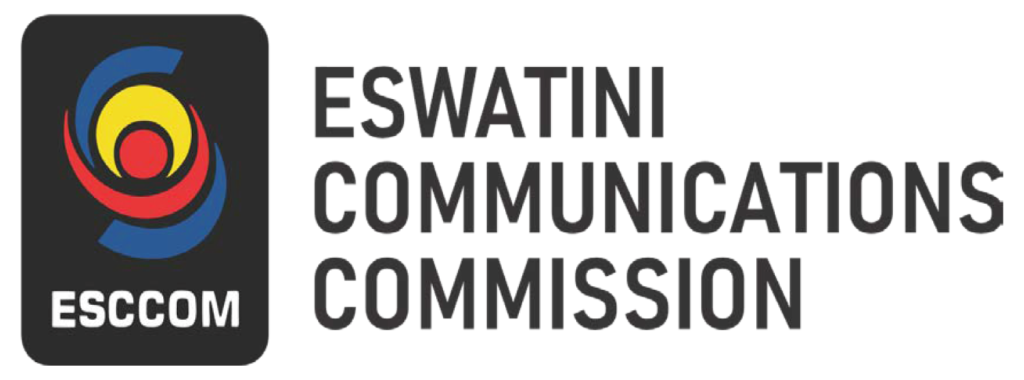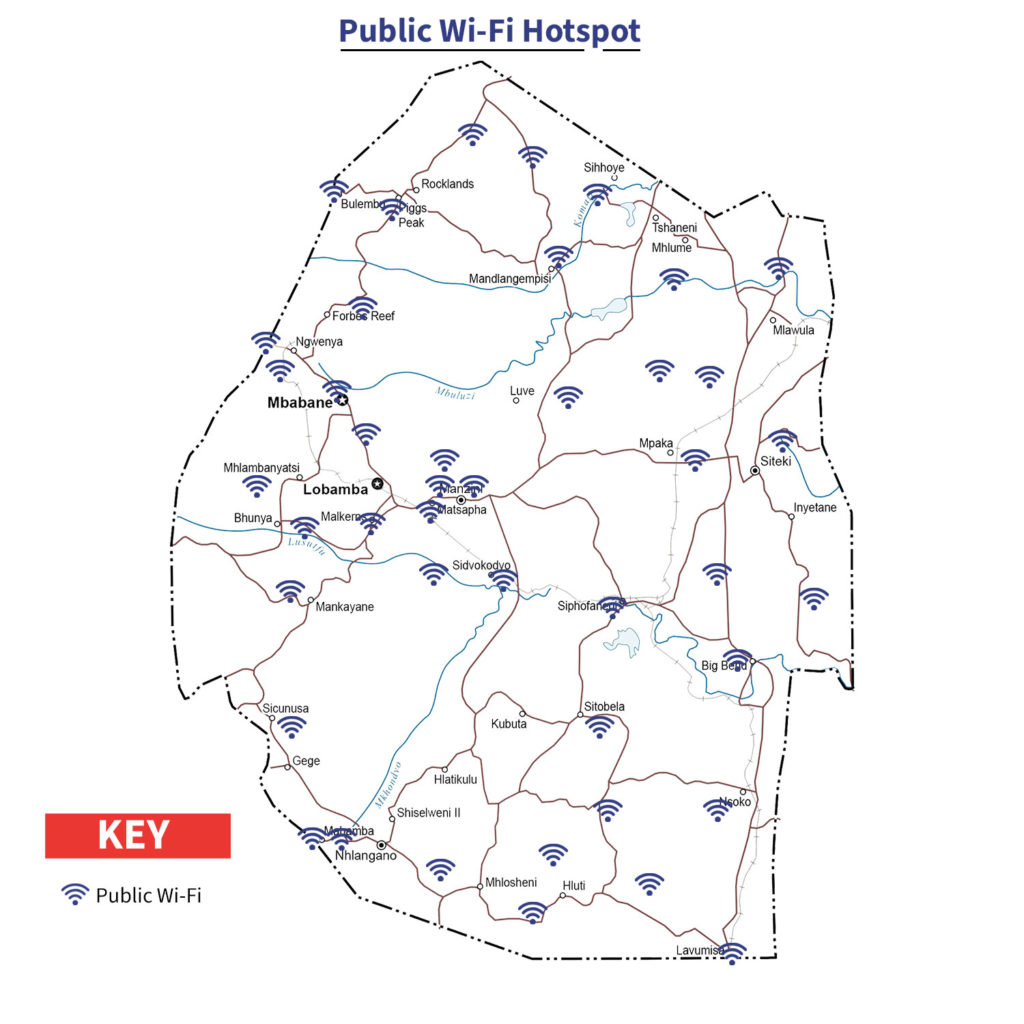Connectivity Programmes
Project Objectives
The primary objective of this project is to enhance the telecommunications infrastructure in Eswatini to provide reliable and stable services, thereby promoting social and economic development for both citizens and businesses. This project is a collaborative effort with the Eswatini Posts and Telecommunications Corporation (EPTC), the national backbone operator, to establish redundancy connectivity and improve broadband and internet infrastructure.
Read More...
Project Description
The Universal Access and Service Fund (UASF) initiated this project in response to a growing concern over frequent backbone and internet network failures and service disruptions experienced through the EPTC network. These issues have resulted in degraded quality of service for consumers and businesses. It was evident that many of these problems originated from a single point of failure – the upstream provider in South Africa, to which EPTC was heavily reliant for connectivity through its North, West, and South routes.
The main issues encountered by EPTC included:
Power Outages: Frequent power outages caused by ESKOM load shedding schedules in South Africa disrupted services.
Fiber Breakdowns: Major routes experienced frequent fiber breakdowns due to road construction activities and cable theft.
To address these critical challenges, the UASF, in partnership with EPTC lead to the establishment of an alternative connectivity route towards the east. This new route would provide redundancy for the primary links to upstream providers in South Africa and enable regional connectivity via the MOTRACO Powerline fiber links, thus minimizing infrastructure vandalism. This route is connecting the national backbone infrastructure via Maputo, Mozambique, and providing a link to the undersea cable in Cape Town, offers redundancy to the primary North, West, and South routes. By doing so, this project aims to prevent the country from becoming a telecommunications “black hole” when service interruptions occur in South Africa through these routes.
To support this initiative, the Fund has procured the necessary equipment required for connecting to the powerline fiber, ensuring the successful implementation of the project. This project not only strengthens the backbone infrastructure but also contributes to the overall stability and reliability of telecommunications services in Eswatini
Project Objectives
This project is a collaborative effort between the Universal Access and Service Fund (UASF) and the Ministry of Agriculture, with the goal of improving connectivity in remote agricultural sites, especially in Rural Development Areas (RDA). By establishing a robust network connection, the project aims to address existing connectivity gaps and enhance agricultural services, information sharing, and resource utilization. The primary objective of this project is to establish robust network connectivity between remote veterinary sites and the Government network.
Below, is a detailed overview of the initiative:
Bridge Connectivity Gaps: Address the lack of network access that has hinders efficient service delivery, particularly in Rural Development Areas.
Improve Agricultural Services: Enhance the quality and availability of agricultural services provided to rural communities.
Enhance Information Sharing: Facilitate the sharing of vital information and data among various agricultural sites and government agencies.
Streamline Resource Utilization: Optimize the use of resources, especially in remote locations, to ensure efficient and effective delivery of services.
Read More...
Project Description
This project focuses on improving agricultural services and increasing efficiency in delivering essential support to rural communities. The UASF has been a key partner in this initiative, working in collaboration with the Ministry of Agriculture.
The Ministry of Agriculture has jurisdiction over agricultural activities across the country and operates numerous remote sites, especially in the RDA. However, many of these sites currently lack access to the Government intranet, which creates challenges for officers stationed in these sites and individuals who require access to essential information systems. One of these critical systems is the Eswatini Livestock Identification Traceability System (SLITS), which is vital for farmers nationwide.
In areas where the Government intranet is unavailable, such as the Shiselweni region, farmers are compelled to undertake long journeys to seek assistance. The Ministry also has a system called SASIS (Systems and Services Information System), which has remained non-functional due to resource constraints, including the absence of a Wide Area Network (WAN). With support from the UASF, the Ministry of Agriculture is actively working on developing various systems, including the Soil Testing Reports Management System, Veterinary Medicinal Products System, and National Plant Health Inspectorate Services. These systems require full integration with the Government intranet to operate effectively.
The central focus of this initiative is to establish connectivity between remote veterinary sites and the Government network. This aligns with the Government’s broader objective of decentralizing services, enhancing accessibility, improving information sharing, and optimizing resource utilization. The UASF has played a vital role in assisting the Ministry of Agriculture in connecting 17 remote veterinary offices to the Government network, marking a significant step towards more efficient agricultural services in the RDA.
By addressing connectivity gaps and integrating critical systems, this project contributes to the overall development and modernization of agriculture in rural areas. It ensures that farmers and agricultural officers in remote locations have better access to essential resources, leading to improved agricultural productivity and support for rural communities.

Project Objectives
The main objective of the “Strengthening Eswatini’s Digital Terrestrial Television (DTT) Network” project is to reinforce the infrastructure of Eswatini’s DTT network. This initiative aims to ensure uninterrupted signal availability and enhance overall network resilience. Acknowledging the critical role of a robust DTT network in modern electronic communication sphere, the Ministry of ICT sought support through the UASF.
Read More...
Project Description
In response to the ever-evolving technological landscape, the Ministry of Information Communications and Technology, in partnership with the Universal Access and Service Fund (UASF), has undertaken a project to strengthen Eswatini’s Digital Terrestrial Television (DTT) network. This initiative addresses the challenges faced by the DTT facility, particularly concerning network stability and continuous signal availability.
The project focuses on the following key objectives:
- Addressing Power Interruptions: To mitigate the impact of power interruptions, the UASF has provided support by installing two standby generators. These generators are strategically placed at Kelly and Siteki Transmitter sites, critical nodes in the network topology. This deployment has significantly improved network status and uptime.
- Ensuring Uninterrupted Power Supply: To guarantee a continuous power supply, the Fund has supplied Uninterruptible Power Supply (UPS) units in a number of sites. These units have been strategically installed at crucial locations, including the Mangwaneni, Manzini, Eswatini TV Stream termination hut, and Ntondozi sites. The UPS units facilitate seamless power switching between grid power and generator power, ensuring uninterrupted power supply.
- Enhancing Radio Links: The UASF has supported the project with the deployment of two radio units, including the Ipasolink VR10 equipped with a main card and 12 modems for the Mangwaneni master link, and VR4 for the EBIS link. The installation of the Ipasolink VR10 has led to improved network traffic management by segregating IP streams from other network traffic, thereby enhancing overall network efficiency.
Achievements: The partnership with the UASF has already yielded significant progress in enhancing the resilience of the DTT network. The successful installation of standby generators, UPS units, and radio links has effectively addressed power interruptions and fortified network stability. This initiative marks a substantial leap towards ensuring uninterrupted access to digital terrestrial television services in Eswatini.

Project Objectives
The Healthcare Connectivity Project is a transformative initiative spearheaded by the Universal Access and Service Fund (UASF). This project is designed to significantly enhance the connectivity of rural health facilities to the Government network, with the goal of fortifying the Health Management Information Systems (HMIS). The central objective is to establish a robust, interconnected network that seamlessly transmits crucial healthcare data between health facilities and the central database, thereby revolutionizing healthcare delivery in Eswatini.
Read More...
Project Description
By implementing last-mile connectivity solutions to bridge the gap between health facilities and the central database, the project aims to streamline healthcare processes, improve data sharing, and contribute to better health outcomes for the communities of Eswatini. The project has successfully connected more than 50 health facilities, extending their reach and capabilities. This achievement has had a profound impact on healthcare accessibility and service delivery, particularly in rural areas.
The project has linked a diverse range of healthcare facilities to the network, serving communities across Eswatini. Some of the connected facilities include:
1. Vusweni Clinic
2. Ngonini Clinic
3. Bulandzeni Clinic
4. Mangweni Clinic
5. Motjane Clinic
6. Simple Aid Medical Centre
7. Mgazini Nazarene Clinic
8. Manzini TB Centre
9. King Sobhuza II Clinic
10. Lubombo Referral Hospital
11. Herefords Clinic
12. Lomahasha Clinic
13. Tikhuba Clinic
14. Hlane Clinic
15. Vuvulane Clinic
16. Tambankulu Clinic
17. Big Bend HMCS Clinic
18. Siteki Nazarene Clinic
19. Sithobela Rural Health Centre
20. Nkonjwa Clinic
21. Sinceni Clinic
22. KaMfishane Clinic
23. Nhlangano SOS Clinic
24. Nhlangano HMCS Clinic
25. Nhlangano Health Centre
26. Mbangweni Barracks Clinic
27. New Heaven Clinic
28. Our Lady Of Sorrows Clinic
29. JCI (Mphelandzaba) Clinic
30. Silele Red Cross Clinic
31. Matsanjeni Public Health Unit
32. Mhlosheni Clinic
33. Matsanjeni Shesire Home
34. Nsalitje Clinic
35. Matsanjeni Health Centre
36. Gucuka Clinic
37. KaMfishane(KaNdlovu) Clinic
38. Cabrini Ministries Health Centre
39. Nhlangunjani Clinic
40. Maloma Colley Clinic
41. Ntshanini Clinic
42. Zombodze Clinic
43. MSF Community Fixed Site
44. Mashobeni Clinic
45. Mahandle Clinic
46. Tfokotani Clinic
47. FTM Clinic
48. Tsambokhulu Clinic
49. Mambane Clinic
50. Mbangweni Barrack
51. Lundzi Barrack
52. Ngwenya Barrack
53. BMD Piggs Peak Barrack
54. Revenue Piggs Peak Government
55. Library Piggs Peak Library
56. Ngwenya Port Clinic
57. Immigration Piggs Peak Government
58. Parliament Government
59. EBC Government
60. Mbuluzi Barrack
61. Siteki Barrack
62. Mbutfu Barrack
63. Mananga Barrack
64. Simpa
65. Matsapha Correctional Staff Government
66. Mkhitsini Clinic Clinic
67. Mhlosheni Clinic Barrack
68. Nsalitje Barrack
69. Lavumisa Barrack
Project Objectives
Recognizing the critical importance of efficient service delivery and connectivity, the Ministry of Tinkhundla Administration and Development has embarked on a transformative journey. This project aims to connect Tinkhundla offices, service centres, and regional offices to the national Government network. It is a collaborative effort, made possible through partnership between the UASF and the Government Computer Services and other development partners.
The objective of this initiative is to promote accessibility and bring government services closer to the people. By establishing connectivity to the government’s central database, remote public offices can effectively deliver vital public services to citizens across the nation.
Read More...
Project Description
The Ministry of Tinkhundla Administration and Development plays a pivotal role in coordinating and facilitating development activities and the delivery of public services to citizens. This is achieved through a network of Regional Administration offices, Tinkhundla offices, Tinkhundla Service Centers, and Chiefdom structures. As of now, all Tinkhundla service centres have been successfully connected to the central Government network.
These connected centres provide a range of services, including those offered by various Ministerial departments. These services encompass Home Affairs (including Immigration and Civil Registration), Public Works-Road Transportation, Master of the High Court, Social Welfare, Library services, and Revenue collection.
Tinkhundla Centers connected with the support of the fund are:
HHOHHO: First Phase
- Mhlambanyatsi
- Timphisini
- Maphalaleni
- Siphocosini
MANZINI:
- Manzini South
- Kwaluseni
- Mahlanya
- Hhohho
- Piggs Peak
- Mbabane
- Lobamba
SHISELWENI:
- Shiselweni
- Ntondozi
- Lubombo
- Mhlume
- Lomahasha
- Siphofaneni
LUBOMBO:
- Dvokodvweni
- Hlane
- Nkilongo
- Lugongolweni
- Ludzeludze
- Manzini North
HHOHHO: Second Phase
- Ndzingeni
- Nkhaba
- Ntfonjeni
- Siphocosini
LUBOMBO:
- Gigal
- Lubulini
- Matsantjeni North
- Sithobela
MANZINI:
- LaMgabhi
- Mkhiweni
- Ngwemphisi
- Mangongco
SHISELWENI:
- Gege
- Maseyisini
- Matsantjeni South
- Mtsambama
- Shiselweni I
- Shiselweni II
- Sigwe
- Zombodze Emuva
Project Objectives
This initiative represents a significant step forward in expanding and strengthening the mobile network infrastructure within the nation, with a central focus on enhancing network reliability and redundancy.
The project of upgrading Global System for Mobile Communications (GSM) 2G Sites to 4G aims to empower the people of Eswatini with improved connectivity and access to high-speed internet services. Here is a breakdown of the project objectives:
Strengthening Infrastructure: The UASF is committed to enhancing the mobile network infrastructure to ensure its robustness, reliability, and ability to cater to the growing demand for digital services.
Expanding Coverage: The project seeks to expand the network’s reach, especially in rural and underserved areas, by upgrading existing 2G sites to 4G/LTE technology.
Reliability and Redundancy: Upon recognizing the importance of a reliable network and redundancy in telecommunications. The UASF’s efforts are directed towards achieving these critical elements in the network.
Subsidy Funding Approach: To accomplish this mission, the Fund utilizes a subsidy funding approach to identify suitable licenses for partnerships, while ensuring that the ownership and responsibility of the BTS (Base Transceiver Station) remain with the operators for maintenance and operation.
Read More...
Project Description
This project has made a significant positive impact on the lives of thousands of Emaswati, particularly those in rural areas, by providing them with access to mobile broadband equipped with 4G capabilities.
Below is an overview of the project’s accomplishments:
Improved Data Coverage: The upgrade has resulted in an increase in broadband coverage, enabling more Emaswati to access high-speed internet services, which is essential for education, business, and communication.
Collaboration with Licensed Operators: The Fund in collaboration with licensed operators successfully upgraded 50 existing 2G base stations to 4G/LTE technology, ensuring that the latest technology is accessible to a wider population.
Broadband Traffic Contribution: The traffic generated from these upgraded sites now contributes to 10% of the overall broadband traffic in the country, highlighting the project’s significance in boosting connectivity.
Digital Services Growth: Beyond just improving connectivity, this project has facilitated the growth of digital services, improving the overall quality of life for the people of Eswatini. From e-learning to e-commerce, the upgraded network infrastructure has paved the way for a more digitally connected Eswatini.
The list of upgraded sites:
- Pikiti Hills
- Palata
- Mpuluzi
- Dwalile
- Salem
- Dvudvusini South
- KaMngayi
- Buseleni
- Malanti
- Ngwenyameni
- Mhlumeni Border
- Mahhoshe
- Ndzingeni High School
- Mkhwakhweni
- Mahebedla
- Mahlambi
- Mganda/Lufafa
- KaKholwane
- Mponono
- Mndobandoba
- Kamfishane
- Kumbita
- Mavukutfu
- Ekhwezi
- Entshanini
- Kadangu
- Kulamzinyane
- Lakholwane Hills
- Lubulini
- Lundzi
- Mahlangatsha
- Majikajika
- Mangcongco
- Mashobeni
- Mavukutfu
- Mbangazwe
- Mdzimba barracks
- Mgamudi
- Mponono
- Mpuluzi
- Mvuma
- Nkondolo
- Ntsanjeni
- Nyamazane
- Olos
- Palata
- Sigangeni 2
- Sitsatsaweni

Project Objectives
In a collaborative effort aimed at addressing the digital divide and enhancing access to broadband internet services, the Universal Access, and Service Fund (UASF) in partnership with licensed operators has embarked on a transformative initiative to set up new Global System for Mobile Communications (GSM) site which seeks to increase both geographic and population coverage. The GSM sites have both voice and broadband (internet) enabled technology 4G.
Bridging the Digital Divide: The core objective of this initiative is to bridge the digital divide that exists between urban and rural areas in Eswatini. By extending broadband access to underserved regions, the project seeks to ensure that communities in rural areas have equitable access to information and communication technology (ICT) services.
Enhancing Geographic Network Coverage: Another crucial goal of this project is to enhance geographic network coverage. By strategically placing GSM sites in rural locations, the project aims to expand the reach of telecom services, effectively reducing connectivity gaps across the country.
Read More...
Project Description
This initiative focuses on the establishment of GSM sites in rural areas across Eswatini, significantly boosting both population and geographic network coverage. With a particular focus on the Lubombo and Shiselweni regions, which were identified as the least developed areas in the country, this has already yielded remarkable results.
Key Achievements:
30 New GSM Sites: A total of 30 new GSM sites have been established, equipped with 3G/4G capabilities, leading to a substantial improvement in access to information and communication technology (ICT) services for the population.
Faster and More Reliable Internet Access: These newly established sites have enabled faster and more reliable internet access in rural areas, contributing to improved communication, education, and economic opportunities for residents.
Partnerships and Progress: This initiative, launched by the UASF in partnership with licensed operators, has made significant strides in improving access to broadband internet services in Eswatini’s rural areas. By addressing the connectivity challenges in these regions, the project is actively working to reduce disparities in access to ICT resources.
The journey to bridge the digital divide in Eswatini is well underway, and the UASF, together with its partners, remains committed to ensuring that rural communities have equal access to the benefits of the digital age. This initiative will continue to expand, innovate, and connect the unconnected, making a lasting impact on the lives of Emaswati
The 4G sites that have been established are:
1. Mvusweni (Hhohho)
2. Nkambeni (Lubombo)
3. Sigwe (Shiselweni)
4. Luqolweni (Shiselweni)
5. Ndlandlameni (Manzini)
6. Palata (Lubombo)
7. Mquba (Hhohho)
8. Mpuluzi (Hhohho)
9. Mozane (Shiselweni)
10. Mdlunkhulu (Hhohho)
11. Mgungundlovu (Hhohho)
12. Mnununu (Manzini)
13. Makhonza (Shiselweni)
14. Ka’Phunga (Manzini)
15. Lakholwane (Shiselweni)
16. Lapanda (Manzini)
17. Magongolweni (Lubombo)
18. Sicunusa
19. Mgobodzi
20. Mahlanhlane
21. Mnjoli
22. Nkamanzi
23. Entabeni
24. Mpakeni
25. Moti
26. Godloza
27. Sigcineni
28. Nsalitje
29. Zindwendweni
30. Mhlalweni
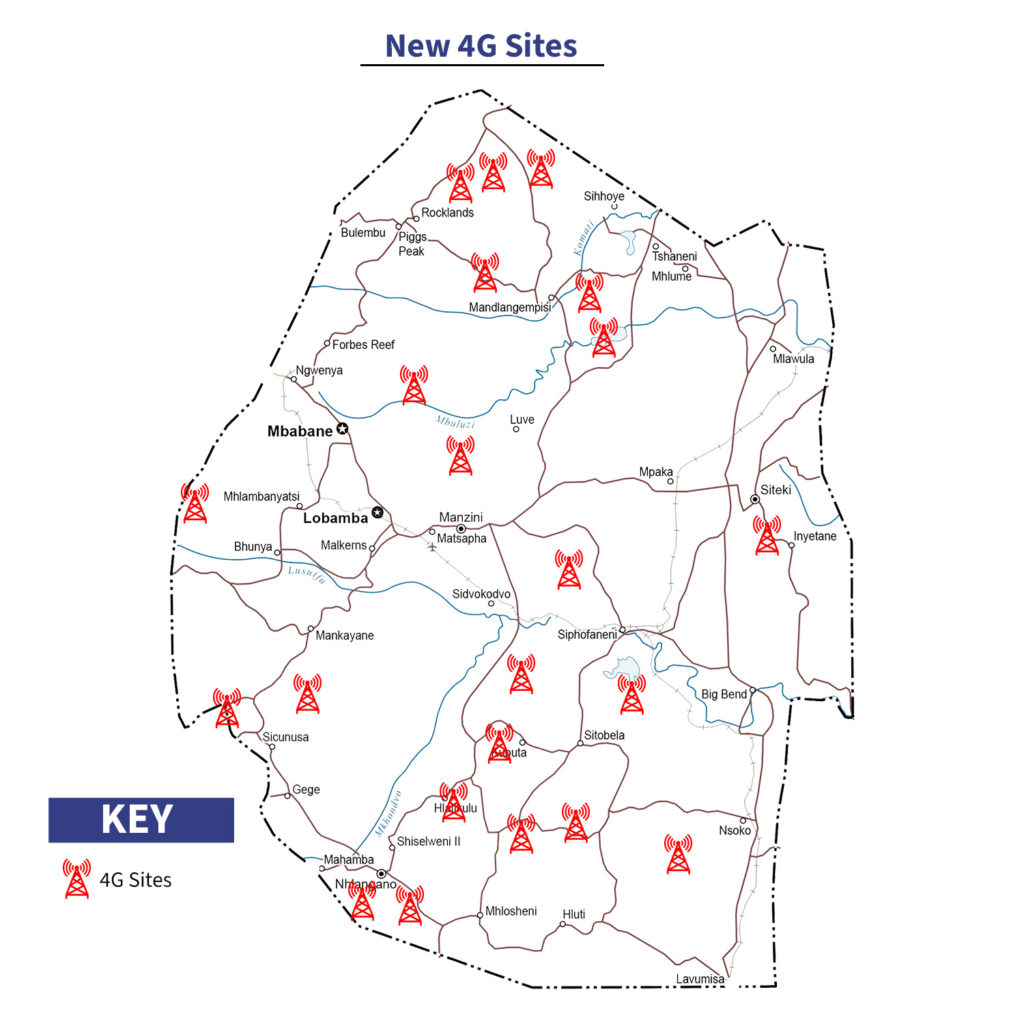
Project Objectives
The Ministry of Tinkhundla Administration and Development, as established by Eswatini’s Government Legal Notice Number 25 of 2009, holds a significant role in fostering an environment conducive to effective service delivery at regional and Tinkhundla levels. Its mission encompasses the promotion of good governance, inclusive development, and balanced regional progress. In line with these objectives, the Ministry has received support from the UASF. The primary aim of this project is to enhance public internet access, especially in underserved areas, by offering subsidized Internet access through Public Wi-Fi Hotspots.
Read More...
Project Description
The Ministry of Tinkhundla Administration and Development stands as a cornerstone of development and public service delivery in the Kingdom of Eswatini. It plays a crucial role in coordinating and facilitating activities at various levels, ensuring essential services are within reach of underserved communities.
To fulfil its objective of improving public internet access, the UASF has spearheaded a campaign to establish subsidized Wi-Fi hotspots in strategic areas. In the 2019/2020 fiscal year, the Fund initiated the placement of Wi-Fi hotspots at key entry points into the country. In 2020/2021, the initiative extended to rural health centres, which witnessed a surge in usage. Users are awarded 500MB of free data, and when this limit is reached, they can recharge their data via coupons or opt for other service providers.
Within these public Wi-Fi hotspots, Emaswati have daily access to 500MB of free data, thus making the internet more accessible to those who were previously underserved and unable to afford data bundles. In the fiscal year 2023, the UASF extended the Wi-Fi service to an additional 20 Tinkhundla Centres. This project, supported by the UASF, marks a significant step towards enhancing public service delivery and fostering development activities by providing Public Wi-Fi access in Tinkhundla Service Centres.
The Fund believes that access to the internet is essential for empowerment, education, and economic development. This initiative aligns with its vision for a more inclusive and connected Eswatini, where every citizen can harness the power of the digital world. It is committed to bridging the digital divide and creating a brighter future for all Emaswati.
The list of connected Tindlundla centres and Public Wi-Fi:
Tinkhundla Centres:
- Dvokodvweni
- Gege
- Gigal
- Hlane
- Kwaluseni
- LaMgabhi
- Lomahasha
- Lobamba
- Lugongolweni
- Ludzeludze
- Lubulini
- Siphocosini
- Sithobelweni
- Mbabane
- Mhlume
- Mhlambanyatsi
- Mahlanya
- Mangcongco
- Manzini North
- Manzini South
- Mhlangatane
- Motshane
- Maseyisini
- Matsanjeni South
- Mayiwane
- Matsanjeni North
- Mpolonjeni Lubombo
- Mkhiweni
- Madlangempisi
- Manzini Halway House
- Ngwempisi
- Nhlambeni
- Nkhaba
- Ntfonjeni
- Ndzingeni
- Nkhaba
- Ntfonjeni
- Piggs Peak
- Ntondozi
- Nkilongo
- Siphofaneni
- Sigwe
- Shiselweni 1
- Shiselweni 2
- Sithobela
- Zombodze Emuva
Border Posts
- Mahamba
- Sikhuphe
- Ngwenya
- Lavumisa
- Matsamo
Public Clinics
- Our Lady of Sorrows Clinic
- JCI (Mphelandzaba) Clinic
- Silele Red Cross Clinic
- Matsanjeni Public Health Unit
- Mhlosheni Clinic
- Matsanjeni Chesire home
- Nsalitje Clinic
- Matsanjeni Health Centre
- Gucuka Clinic
- Sithobela Rural Health Centre
- KaMfishane Clinic
- Nkonjwa Clinic
- Sinceni Clinic
- Cabrini Ministries Health Care
- Nhlangunjani Clinic
- Maloma Colliery Clinic
- Ntshanini Clinic
- Zombodze Clinic
- MSF Community Fixed Site
- Mashobeni Clinic
- Mahlandle Clinic
- Tfokotani Clinic
- FTM Clinic
- Tsambokhulu Clinic
- Mambane Clinic
